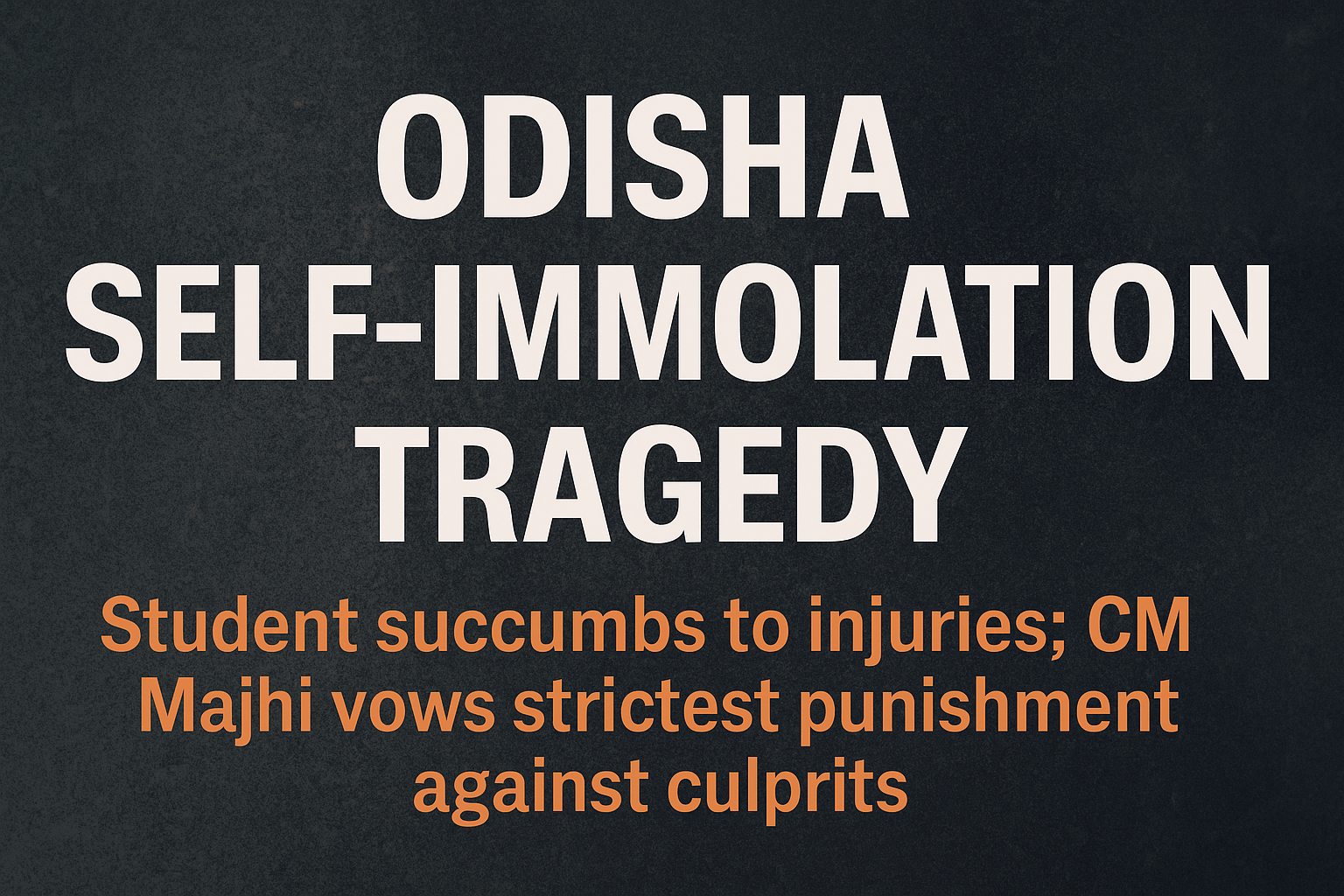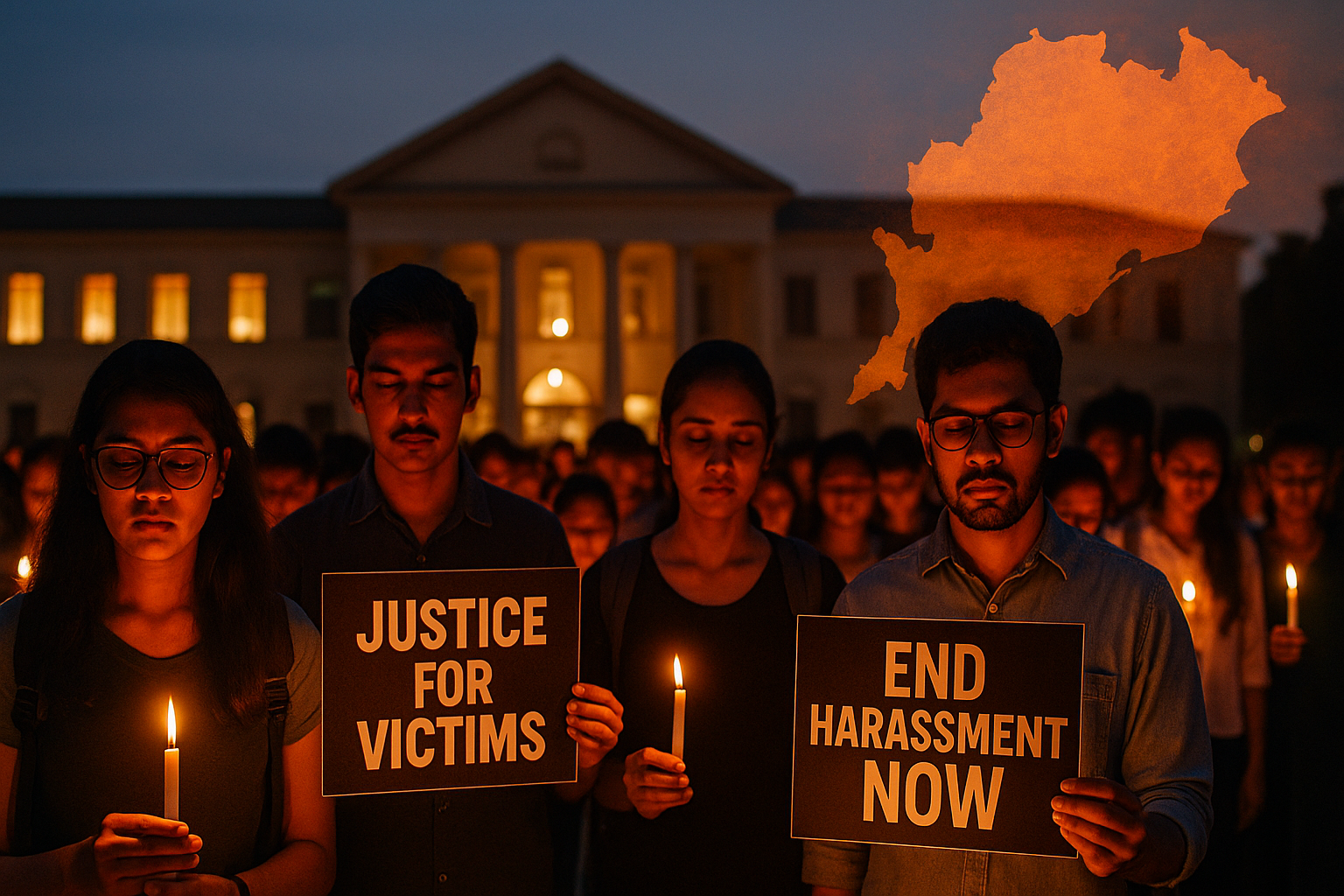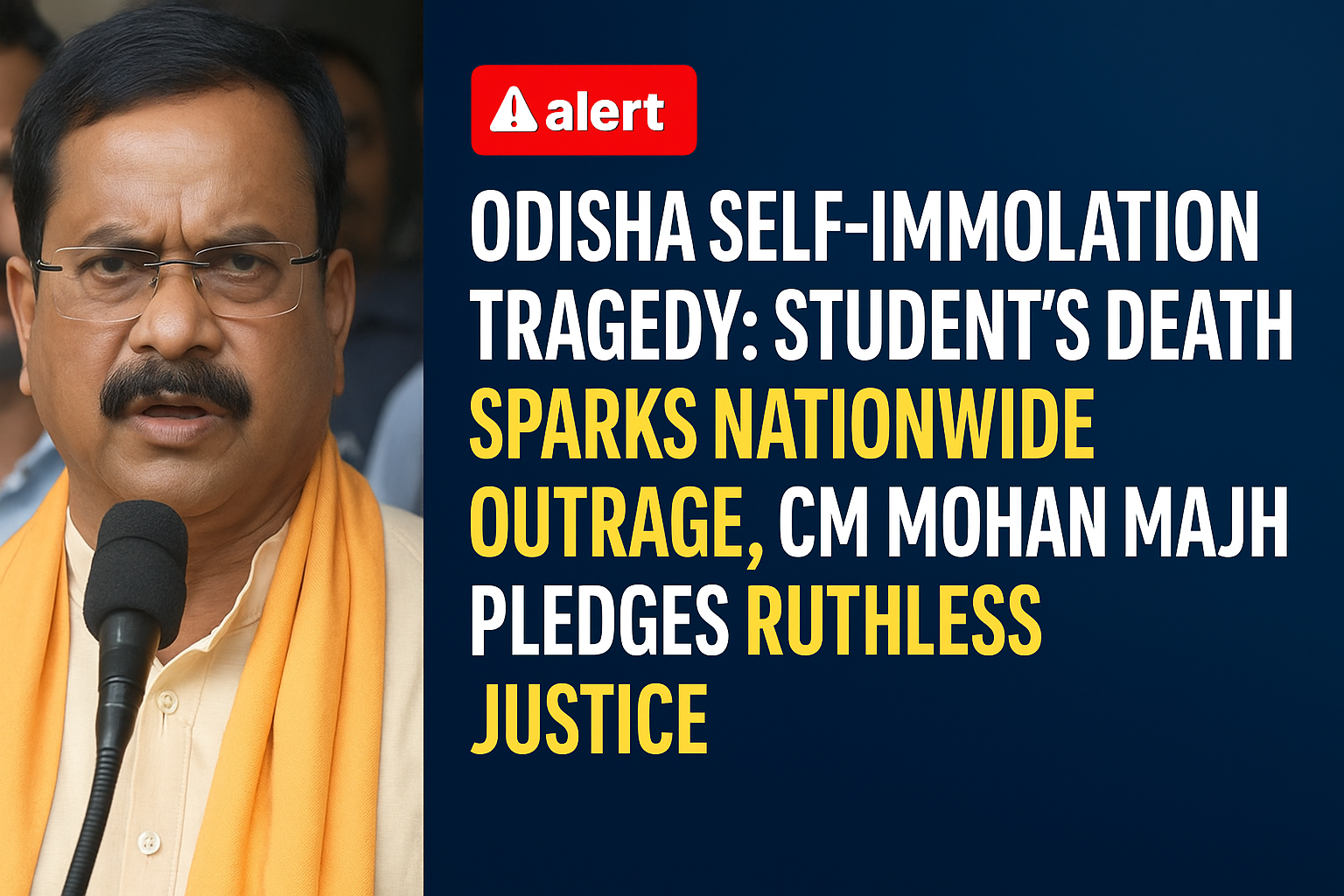Odisha Self-Immolation Tragedy: A State Shaken by Flames and Fury

The chilling events of the Odisha Self-Immolation Tragedy have sent shockwaves across the nation, stirring public consciousness and raising urgent questions about justice, safety, and political responsibility. A young girl’s desperate act of setting herself on fire outside a police station in Odisha has not only claimed her life but also sparked a firestorm of outrage, empathy, and demands for accountability. This tragic incident has pushed the state’s leadership and administrative machinery into swift, if belated, action.
In a country where systemic apathy often overshadows individual tragedies, the Odisha Self-Immolation Tragedy stands out as a heart-wrenching reminder of the dangers faced by vulnerable individuals, especially women, when state mechanisms fail to act. This was not just a singular act of desperation—it was a manifestation of years of neglect, disregard for women’s safety, and an insensitive administrative apparatus that failed to act when it mattered most.
The Shocking Incident That Shook Odisha
On July 5th, a 22-year-old woman from the tribal-dominated district of Bargarh in Odisha reportedly poured kerosene over herself and lit a match outside the Paikamal police station. Her condition was critical from the outset, and despite the best efforts of doctors in Burla and later in Raipur, she succumbed to her severe burn injuries on July 13th. The Odisha Self-Immolation Tragedy has thus escalated from a personal outcry to a full-blown public and political crisis.
The woman’s last days were marked by unimaginable pain and silence. Over 90% of her body was covered in burns, leaving little hope for recovery. Despite this, she managed to record a dying declaration, which has now become a crucial piece of evidence in the investigation. According to her statement, she was harassed continuously, and her repeated complaints to the local police were met with indifference. Her death has become a rallying point for civil society and human rights activists demanding accountability.
The Odisha Self-Immolation Tragedy underscores the critical need for a police force that is sensitive and responsive to the needs of citizens, especially women from marginalized communities. When cries for help go unheard, it reflects poorly not just on the police, but on the very ethos of democracy and justice.
CM Mohan Majhi’s Reaction: A Pledge for Justice
Following the incident, Odisha’s newly appointed Chief Minister, Mohan Charan Majhi, expressed deep anguish and made a bold commitment. Declaring that the culprits will not be spared, he has assured the public that the government will pursue the “strictest punishment” for those responsible. His statement came amidst mounting pressure from opposition parties and civil society groups demanding swift action.
Majhi’s reaction to the Odisha Self-Immolation Tragedy was swift. He visited the victim’s family, offered condolences, and ordered a Crime Branch probe. He also announced compensation and free legal aid to the family. These actions were a stark contrast to the previous silence and inaction of local authorities. The CM’s visit was also politically significant, as it showed the ruling government’s intent to reclaim public trust.
The Odisha Self-Immolation Tragedy has become the first major test for the Majhi government’s resolve on law and order. The CM emphasized that his administration would not tolerate any form of injustice, especially when it involves women. He instructed top police officials to take immediate steps to ensure accountability and prevent such incidents in the future.
The Role of the Police Under Scrutiny
Perhaps the most alarming aspect of the Odisha Self-Immolation Tragedy is the alleged inaction of the local police. The victim’s family alleges that their repeated attempts to seek help were met with indifference. Allegedly, the station in-charge refused to register a complaint or act against those who threatened her. This has triggered widespread criticism and protests, with many demanding accountability from the police department.
Two police officers, including the inspector-in-charge of Paikamal police station, have been suspended. But for many, these actions are too little, too late. Public confidence in law enforcement has been deeply shaken by the Odisha Self-Immolation Tragedy. Protests across the state have called for deeper reforms in police conduct and training, particularly regarding handling gender-based complaints.
The incident has prompted calls for more robust internal accountability within the police department. There are demands for the establishment of independent police complaint authorities at the district level. Activists are also urging the Odisha government to implement gender-sensitivity training across all levels of law enforcement. The Odisha Self-Immolation Tragedy has exposed the dire consequences of unchecked police apathy.
Political Overtones and Public Outrage

The Odisha Self-Immolation Tragedy has naturally taken on a political dimension, with rival parties pointing fingers and accusing each other of negligence. The Bharatiya Janata Party (BJP), which recently came to power in the state, has been accused by the opposition of exploiting the tragedy for political mileage. In contrast, BJP leaders claim that such incidents are the result of years of systemic decay and poor governance under the previous administration.
In this political blame game, the real issue—the loss of a young life—risks being overshadowed. However, citizen outrage has ensured that the Odisha Self-Immolation Tragedy remains a central issue. Civil society groups, women’s organizations, student bodies, and legal activists have united in calling for justice.
The impact of the tragedy has also been felt on social media. Hashtags such as #JusticeForOdishaVictim and #OdishaSelfImmolationTragedy have trended nationwide, putting additional pressure on the authorities to act swiftly. Memes, videos, and user-generated content have been shared widely, fueling digital activism. For many, the Odisha Self-Immolation Tragedy represents the tipping point in a long history of administrative failure and gender-based violence.
National Ramifications of the Odisha Self-Immolation Tragedy
As the case garners national headlines, it is serving as a wake-up call for the entire country. The Odisha Self-Immolation Tragedy is not just a regional crisis—it reflects a pan-Indian pattern of apathy, gender-based violence, and administrative inefficiency. Activists argue that unless police accountability mechanisms are strengthened, such tragedies will continue to happen.
Several national leaders have condemned the incident and extended their condolences to the grieving family. Human rights organizations are calling for legal reforms to ensure swift justice in cases of harassment and negligence. The Odisha Self-Immolation Tragedy is now at the heart of a broader conversation on women’s safety and public trust in institutions.
Parliamentarians have raised the issue during sessions, demanding nationwide reforms. There is growing consensus that India needs a centralized monitoring system for complaints made at police stations, especially those related to harassment and violence against women. If implemented, such a system could become a direct response to the lapses that led to the Odisha Self-Immolation Tragedy.
Media Coverage and Ethical Questions
As television channels and news portals race to cover every aspect of the Odisha Self-Immolation Tragedy, questions have also been raised about ethical journalism. Was the identity of the victim protected? Were the images respectful of her dignity? The media frenzy has, in some cases, bordered on sensationalism, adding another layer of controversy to an already volatile issue.
However, the extensive media coverage has also helped keep the pressure on the authorities. In the age of digital activism, sustained coverage of the Odisha Self-Immolation Tragedy has galvanized support for the victim’s family and forced the administration to act decisively.
The role of the media is dual—it informs but also influences. In the case of the Odisha Self-Immolation Tragedy, responsible journalism has helped bring facts to light, uncover inconsistencies in official statements, and ensure public attention doesn’t waver. But it also serves as a reminder of the media’s responsibility to report sensitively, especially in cases involving trauma.
The Victim’s Legacy: A Call for Change
Though her life was tragically cut short, the young woman at the center of the Odisha Self-Immolation Tragedy has inadvertently sparked a movement. Her act of desperation has exposed the cracks in the justice system and challenged the conscience of a state. The incident has triggered demands for better grievance redressal mechanisms, improved policing standards, and greater sensitivity toward women’s issues.
Her story has been immortalized in art, literature, and activism. Murals depicting her story have appeared in Bhubaneswar, and university students have organized symposiums to discuss systemic reforms. NGOs are using the Odisha Self-Immolation Tragedy as a case study to advocate for structural changes in how complaints of harassment are handled.
Many are now calling for the establishment of dedicated women’s help desks in every police station, fast-track courts for cases of harassment, and stricter monitoring of police conduct. The Odisha Self-Immolation Tragedy may have begun with a personal cry for help, but it has become a collective call for reform.
A Long Road Ahead: Justice and Healing
As the Odisha Self-Immolation Tragedy continues to unfold, it is clear that justice will not be served by punitive actions alone. True justice will require a transformation in attitudes, systems, and policies. Healing will take time, not just for the victim’s family, but for a state—and a nation—that must now confront the real cost of indifference.
The Odisha Self-Immolation Tragedy is a sobering reminder of the human toll of systemic failures. It challenges us to listen more, act faster, and care deeper. In memory of the young woman who lit a flame to make herself heard, let us vow to ensure that no other soul finds silence more terrifying than fire.
Public memory is short, but justice must be enduring. The Odisha Self-Immolation Tragedy should serve as a turning point, compelling policymakers, administrators, and citizens to work toward a society where such horrors no longer occur. Let this tragedy be not the end, but the beginning of a new era of accountability and reform.

